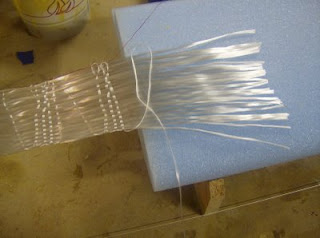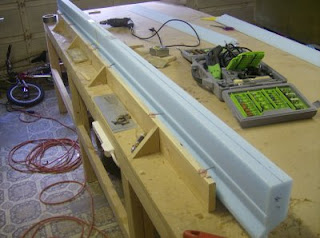I nearly overfilled the spar cap trough. After finishing and sitting down to rest with a cold beverage, I started to concern myself with it, so against better advise I got up and started messing with it. Actually I am glad I did. I used the bottom contour template as a sort of squeegee and forced any excess epoxy to the ends of the spar caps, they were a little low anyhow. So in the end all is well. I will try and be a little more carefully with future spar caps to ensure they are not over filled. I can image the difficulty in sanding down the cured cap without damaging the adjacent foam.
Here is a close up of the unidirectional spar cap tape. If you look closely you can see a red thread. That thread is easily pulled out, even at the full length of the spar. After removal of the thread, the crossing glass fibers can be pulled out leaving only the heavy unidirectional glass along the length of the spar.

Here is a hight tech caveman tape dispenser I made. Also if you look close you can see the little 3" squeege I made. I epoxied the trimmed down subway bonus card into a block of wood so I could handle it better with epoxy soaked gloves. It worked out great and was free!.

The bottom contour template. This worked great as a final squeegee to ensure the spar cap was flush with the remainder of the airfoil. Because I probable used a little too much glass and epoxy there is some minor contamination to the foam. Probably trivial when compared to an overfilled spar cap.

Spar cap complete and peel plied.















